| Main |
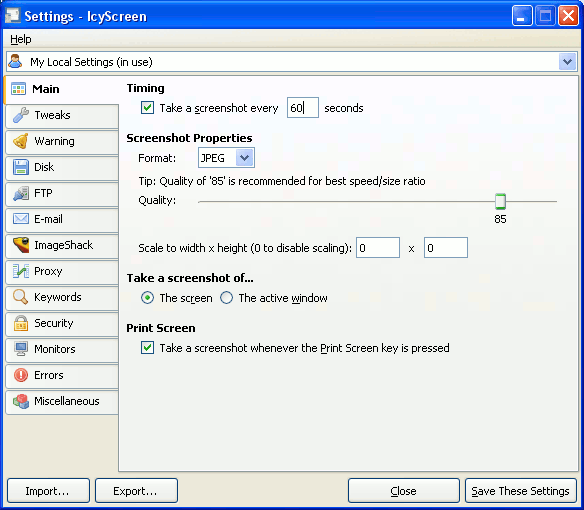 |
Take a screenshot every X seconds: IcyScreen will take a screenshot at this interval, and then will save, e-mail, and/or upload the screenshot, depending on how IcyScreen is configured.
If this option is not set, another screenshot won't be taken for another X seconds after the save and/or upload has completed -- regardless of how long the process took to complete.
This option is enabled by default.
Format: Choose the format to save the screenshot image in:
- JPEG: One of the most common image formats. Low CPU usage, with decent quality overall, producing a medium sized file -- depending on the quality setting.
- GIF: Another very common format. Produces a very small file; however, CPU usage can be high, and due to the nature of the format the accuracy of the colors can be low (depending on the sampling factor).
- PNG: Increasingly becoming more popular due to the high quality and relatively small size of the file. Uses more CPU than JPEG but the quality is worth it. Very good if you have a lot of colors/text on the screen, as well.
- TIFF: Less common, but produces a large, uncompressed, very high quality image, using very little CPU. This format is currently unavailable if you are using Windows 98/ME.
- BMP: Much like TIFF in that it produces a large, very high quality image, using very little CPU. More common than TIFF.
- ICO: Depending upon the depth setting, the CPU usage and size of this image is close to the CPU usage and size of what a JPEG image might be. However, the maximum width and height of an ICO file is 255x255; also, this format is unsupported by ImageShack.
Quality/Compression/Sampling factor/Depth: Does not exist when the BMP or TIFF format is selected. Move the slider back and forth to change this property. The direction you move the slider will have a different effect depending upon the image format you have selected:
- JPEG (Quality): Move the slider to the right to increase the image quality and consequently the file size.
- PNG (Compression): Move the slider to the right to increase the compression setting, which decreases the file size. This option is currently unavailable if you are using Windows 98/ME.
- GIF (Sampling factor): Move the slider to the right to increase the sampling factor, which decreases color accuracy in the image but uses less CPU.
- ICO (Depth): Move the slider to the right to increase the bit-depth of the image; this increases both the quality and file size.
Scale to width x height: If set to something other than '0', the screenshot will be scaled to this width and/or height. The maximum amount if the image format "ICO" (icon) is selected is "255" for both fields.
Take a screenshot of...
- The screen: Take a screenshot of the monitor(s) you have configured in the Monitors tab. This option is enabled by default.
- The active window: Only the active window will be included in the screenshot.
Take a screenshot whenever the Print Screen key is pressed: Whenever IcyScreen detects that the "Print Screen" key was pressed on the keyboard, a screenshot will be taken and saved, e-mailed, and/or uploaded, depending upon the settings.
IcyScreen does not need to be turned on in order for this option to have an effect.
Go back to top |
| Tweaks |
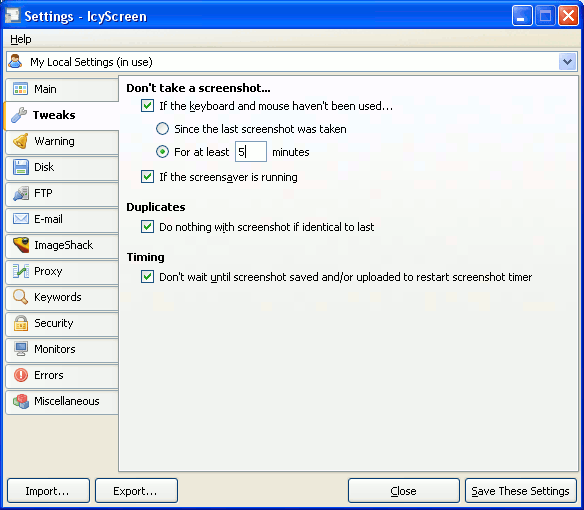 |
Don't take a screenshot (Windows 98/ME not supported)...:
- If the keyboard and mouse haven't been used...
- Since the last screenshot was taken: If neither the keyboard nor the mouse have been used (keys pressed, mouse moved or clicked, etc) since the last screenshot was taken, a screenshot will not be taken. The interval timer will reset and continue "ticking".
- For at least X minutes: If neither the keyboard nor the mouse have been used for at least X minutes, a screenshot will not be taken. The interval timer will reset and continue "ticking".
- If the screensaver is running: If the screensaver is running when the timer elapses, a screenshot will not be taken. The interval timer will reset and continue "ticking".
Do nothing with screenshot if identical to last: If this is enabled, after each screenshot is taken IcyScreen will compare it with the previous screenshot that was taken. If the two are identical, the screenshot won't be saved, uploaded or e-mailed. This option is quite fast.
Don't wait until screenshot saved and/or uploaded to restart interval timer: Instead of waiting until after the screenshot has been saved and/or uploaded, this option will force the interval timer to restart immediately after the screenshot is taken.
If this option is set, and the time it takes to save and/or upload the screenshot is less than the interval value, this will ensure that a screenshot is taken every X seconds. On the other hand, if this option is set and the time it takes to save and/or upload the screenshot is greater than, or equal to, the interval value, a screenshot will be taken immediately after all saving/uploading methods have completed.
Go back to top |
Warning |
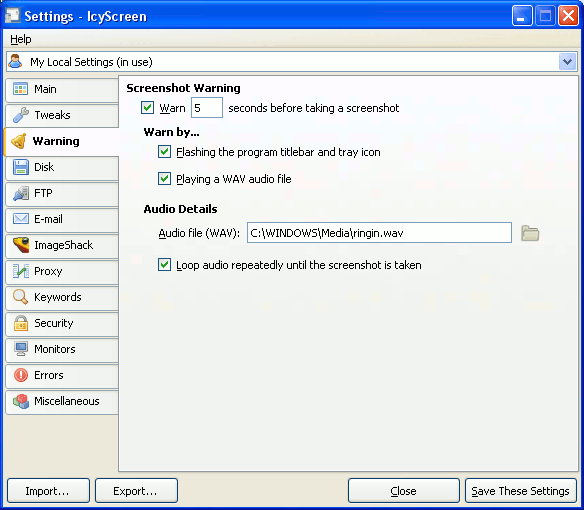 |
Warn X seconds before taking a screenshot: If selected, you will be warned X seconds before a screenshot is taken, using the method(s) selected below.
Warn by...
- Flashing the program window and tray icon: This warning method flashes the program window and the system tray icon.
- Playing a WAV audio file: This warning method plays the audio file specified in the Audio file (WAV) entry field.
Audio file (WAV): Fill this field with the location of the audio file (in WAV format) that you'd like IcyScreen to play to warn you before the screenshot is taken. If this field does not contain the location of a valid WAV file, the default system sound will be played instead.
If you've got an audio file you'd like to use that's not in the WAV format, we recommend using the free dBpoweramp to convert it.
Loop audio repeatedly until screenshot is taken: Instead of playing the specified audio file once, it will be played repeatedly until the screenshot is taken.
Go back to top |
Disk |
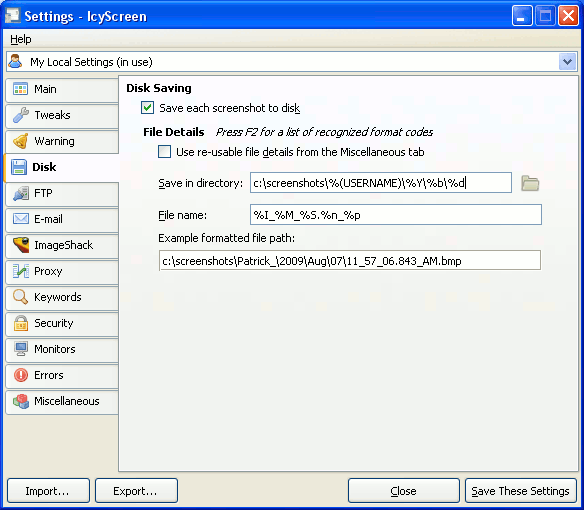 |
Save each screenshot to disk: Save each screenshot to disk.
Use re-usable file details from the Miscellaneous tab: Check this to use the re-usable file details (set in the Miscellaneous tab tab) as the file details for this method, instead of the settings in the text boxes filled below.
Save in directory: Enter the directory path in which you would like to save your screenshot. If the directory does not exist, IcyScreen will attempt to create it.
Format codes are supported in this entry.
File name: The screenshot's file name.
Format codes are supported in this entry.
Go back to top |
FTP |
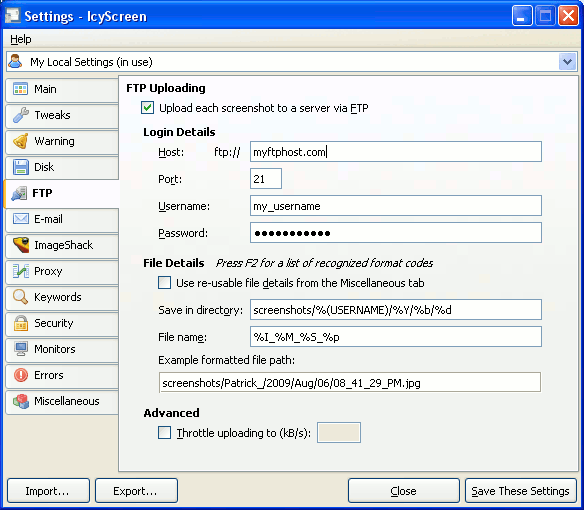 |
Upload each screenshot to a server via FTP: Upload each screenshot to a server via FTP.
Host: Enter the host URL of the FTP server which you would like to upload your screenshot to.
Port: The port through which to connect to the FTP host. Usually this is 21.
Username: If the FTP server requires that you enter a username in order to connect to the FTP server, enter it here.
Password: Enter your FTP password, if your server requires one.
Use re-usable file details from the Miscellaneous tab: Check this to use the re-usable file details (set in the Miscellaneous tab) as the file details for this method, instead of the settings in the text boxes filled below. The "Save In Directory" setting will not be replaced, however.
Save in directory: Enter the directory path (on the FTP server) in which you would like to save your screenshot. If the directory does not exist, IcyScreen will attempt to create it.
Format codes are supported in this entry.
File name: The file name of the screenshot on the FTP server.
Throttle uploading to (kB/s): Check this to enable upload throttling; IcyScreen will throttle it's upload speed to the value in the text box (in kilobytes per second).
Unresponsive server timeout (seconds): If the FTP server is unresponsive for the number of seconds you specify, then IcyScreen will close the connection to the server, consider the attempted transfer a failure, and handle the situation as it would any other error, using the settings configured in the Errors tab.
Go back to top |
E-mail |
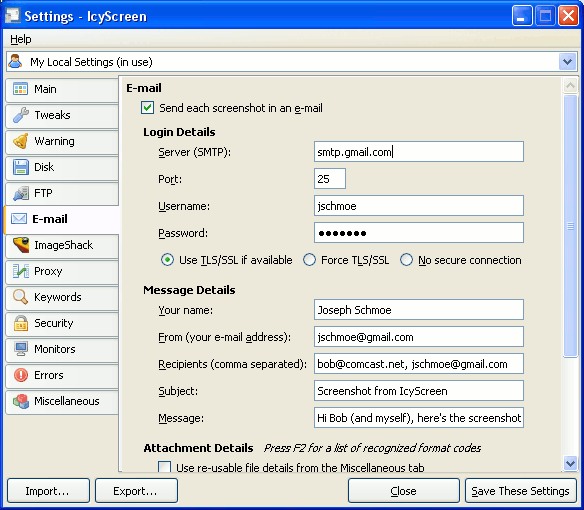 |
Send each screenshot in an e-mail: Send a screenshot to the specified e-mail address(es) whenever a screenshot is taken.
Server (SMTP): The location of the SMTP server through which you would like to send the e-mail.
If you don't already have an e-mail account, you can get one for free from GMail, Lavabit, and quite a few other places -- most come with a large amount of free space, too.
If you're not sure how to fill these fields out, you have a few options:
- 1) Use the e-mail settings from your e-mail client (such as Outlook, Thunderbird, Eudora, etc) as a reference.
- 2) Refer to your ISP/e-mail provider's documentation for more information.
In either case, you can usually safely assume that the SMTP server address will be 'smtp.PROVIDER.com', where provider is the email provider's domain name, such as 'gmail', 'lavabit', 'yahoo', etc.
Port: The port through which to connect to the SMTP server. Usually this 25.
Username: Your e-mail account username.
Password: Your e-mail account password.
Use TLS/SSL if available: If the server supports secure TLS/SSL connections, IcyScreen will connect to the server securely; otherwise, no secure connection will be established.
Force TLS/SSL: IcyScreen will try to connect to the e-mail server using a secure connection via TLS/SSL. If your e-mail provider does not support secure TLS/SSL connections, the connection will fail and you will be notified.
No secure connection: No secure connection will be established with the e-mail server, regardless of whether or not it supports it.
Your name: This will show up in the "From" section of the e-mail IcyScreen sends. You can leave it blank if you only want your e-mail address shown to the recipient(s).
From (your e-mail address): This is the e-mail address that will be shown in the "From" section of the e-mail IcyScreen sends. Many e-mail providers will ignore this field and use username@domain.com, where username is your login username, and domain is the domain of the e-mail address (like gmail.com).
Recipients (comma separated): IcyScreen will send the screenshot to all of the e-mail addresses entered in this field; separate each address with a comma (e.g., email1@test.com, email2@email.com, email3@16software.com). You can even send an e-mail to yourself, if you'd like.
Subject: The subject of the e-mail that is sent.
Message: The message to be inserted in the e-mail.
Use re-usable file details from the Miscellaneous tab: Check this to use the re-usable file details (set in the Miscellaneous tab) as the attachment file details for this method, instead of the settings in the text boxes filled below.
Attachment file name: The file name of the screenshot that will be attached to the e-mail.
Format codes are supported in this entry.
Ignore invalid security certificate errors: Only valid if enabling a secure connection method (TLS/SSL). If you're getting error messages regarding invalid security certificates, select this to ignore them and continue with the transfer anyway. This probably isn't a very good idea if you want a secure connection; an invalid security certificate could mean that the connection is not secure, or the server isn't who it says it is.
Go back to top |
ImageShack |
| ImageShack is a popular and well-known image hosting service that offers free, unlimited image storage online. |
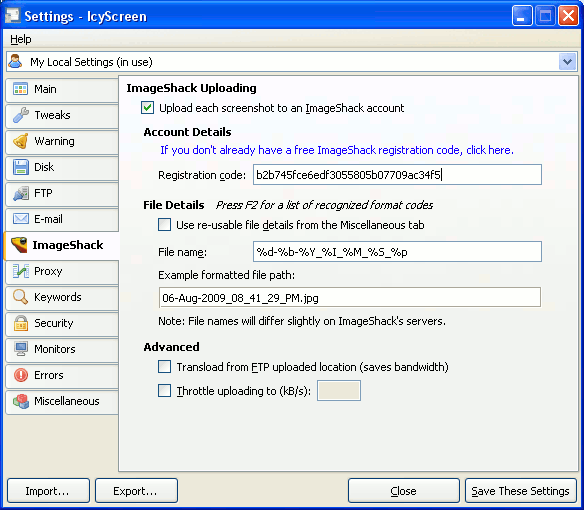 |
Upload each screenshot to an ImageShack account: Check this to enable ImageShack uploading. Your screenshot will then be uploaded into your ImageShack account.
Registration code: Enter the registration code you received from ImageShack via e-mail after you registered for a free account. If you haven't registered yet, click the link in the program to do so. You should then receive your registration code from ImageShack via e-mail within a few minutes.
In the automated e-mail that is sent, look for a 32-character string of letters and numbers. This is the registration code that you should enter into this field.
Use re-usable file details from the Miscellaneous tab: Check this to use the re-usable file details (set in the Miscellaneous tab) as the file details for this method, instead of the settings in the text boxes filled below.
File name: The file name for the screenshot uploaded to ImageShack. Please note that due to the way ImageShack works, the file name will differ slightly on ImageShack's servers.
Format codes are supported in this entry.
Transload from FTP uploaded location: Only available if FTP uploading is enabled, this option will use the screenshot already uploaded to the FTP server, instead of uploading it all over again. Using this option uses half the bandwidth, and in almost all cases will be much, much faster. The file details will be shared with the ones set in the FTP tab. If you want to throttle the speed of this operation, you should set the throttle speed in the FTP settings tab.
Note: While in most cases this option works perfectly, this option will not work if the configured FTP host name does not point to the location where the FTP server stores uploaded files. For example, if you cannot access your server's files by using a web browser to navigate to the FTP host name you have configured, this option likely will not work.
Throttle uploading to (kB/s): Ignored if Transload from FTP uploaded location is enabled. Check this to enable upload throttling; IcyScreen will throttle it's upload speed to the value in the text box (in kilobytes per second).
Go back to top |
|
Proxy |
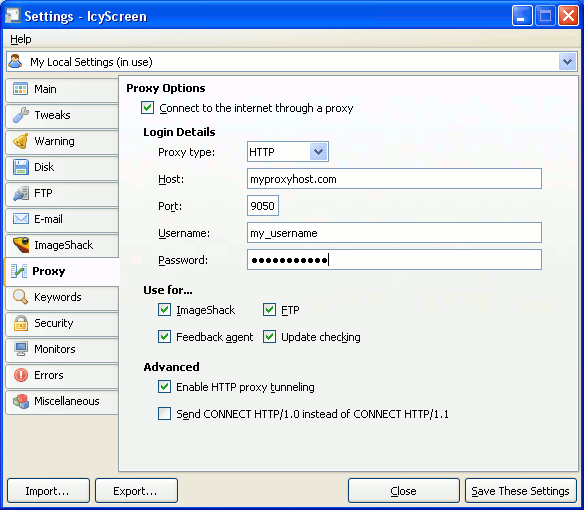 |
Connect to the internet through a proxy: Enable this to connect to the internet through a proxy.
Host: Enter the host URL of the proxy server you would like to connect to.
Port: The port through which to connect to the proxy host.
Username: If you need to provide a username to the proxy server in order to use it, enter it here.
Password: Enter your proxy password, if needed.
Use for... Check each method below to have IcyScreen perform that method through a proxy. "Feedback Agent" is for sending us messages with the integrated Feedback Agent (Help -> Send Us A Message); "Update Checking" is for checking for updates with the integrated update checker.
Enable HTTP proxy tunneling: Check this to enable proxy tunneling through HTTP; this only works if you are using an HTTP proxy. If you are having trouble uploading data to your FTP server through your HTTP proxy, try enabling this.
Send CONNECT HTTP/1.0 instead of CONNECT HTTP/1.1: Since version 2.00, IcyScreen now sends the more common CONNECT HTTP/1.1 request, instead of the older CONNECT HTTP/1.0 request. If you're experiencing problems connecting to your HTTP proxy, try enabling this setting.
Go back to top |
Keywords |
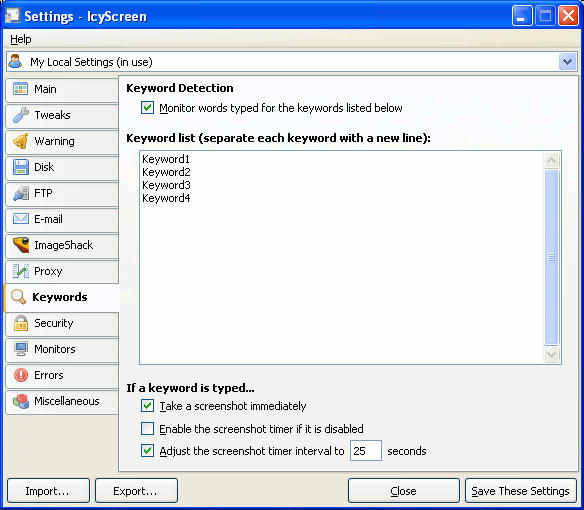 |
You can have IcyScreen monitor words typed on the keyboard for certain keywords, and have it take a specific action when one of the keywords has been typed.
Monitor words typed for the keywords listed below: If this option is enabled, IcyScreen will monitor words typed for the keywords listed in the text entry below. If this option is not enabled, IcyScreen will not monitor for keywords.
Keyword list: Enter the keywords you wish to have detected in this text entry; separate each keyword with a new line. The keyword can be as long or as short as you'd like, and case is ignored, so each keyword can be all lowercase, all uppercase, or a mixture of both, without having an effect on detection.
If a keyword is typed...
- Take a screenshot immediately: A screenshot will be taken as soon as one of the keywords has been typed. IcyScreen does not need to be turned on in order for this option to have an effect.
- Enable the screenshot timer if it is disabled: If the screenshot timer (represented by the Take a screenshot every X seconds option in the Main tab) is disabled, when a keyword is typed, it will be enabled until you turn IcyScreen off, restart the program, or disable this option. IcyScreen must be turned on in order for this option to have an effect.
- Adjust the screenshot timer interval to X seconds: Enable this to have the screenshot timer interval (represented by the Take a screenshot every X seconds option in the Main tab) adjusted to the value you enter as soon as a keyword is typed.
The timer will stay adjusted to this value until you turn IcyScreen off, restart the program, or disable the option. IcyScreen must be turned on in order for this option to have an effect.
Go back to top |
Security |
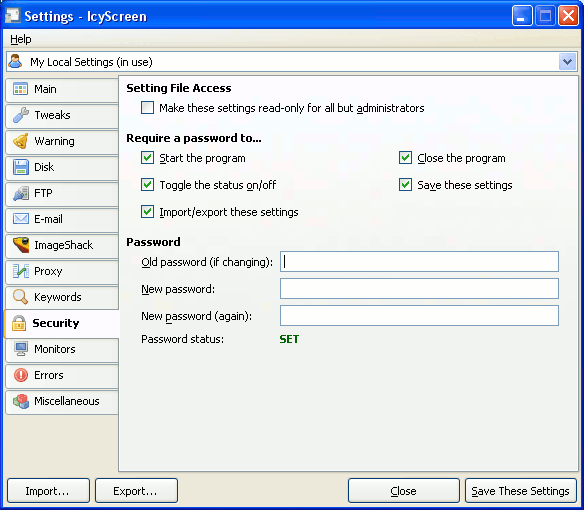 |
Make these settings read-only for all but administrators: If you are using an NTFS file system (you most likely are, unless you are using a very old version of Windows) then enabling this option will forbid regular, limited users with no administrator privileges from deleting and modifying the setting file, both from within the program as well as on disk. Disabling this option will allow all users to modify the setting file from within the program (unless you have enabled password protection for setting saving) as well as on disk.
Limited users with no administrator privileges will not be able to disable this option if it is enabled.
This option is very useful for administrators who want to keep certain users from modifying, or even deleting, their settings.
Note: Users who are using Windows Vista/7 will need to run IcyScreen with elevated administrator privileges in order to modify this setting. To run IcyScreen with elevated administrator privileges, simply right-click IcyScreen's icon and select 'Run as Administrator'.
Require a password to...
Start the program: Check this to password-protect program startup. You will be required to enter your password (set below) when IcyScreen first starts.
Close the program: Check this to require a password to exit IcyScreen.
Toggle the status on/off: Check this to password-protect changing the on/off status.
Save these settings: Require a password to save these settings from within the program.
Import/export these settings Check this to password-protect importing and exporting these settings.
Old password (if changing): If you are changing your password enter it here. This is only required if you are changing your password.
New password: Enter the password required to bypass any password-protected functionality.
New password (again): Enter the password you entered in the "New Password" text box.
Password status: If your password is set, the password status will show as SET; otherwise, it will show as UNSET.
Go back to top |
Monitors |
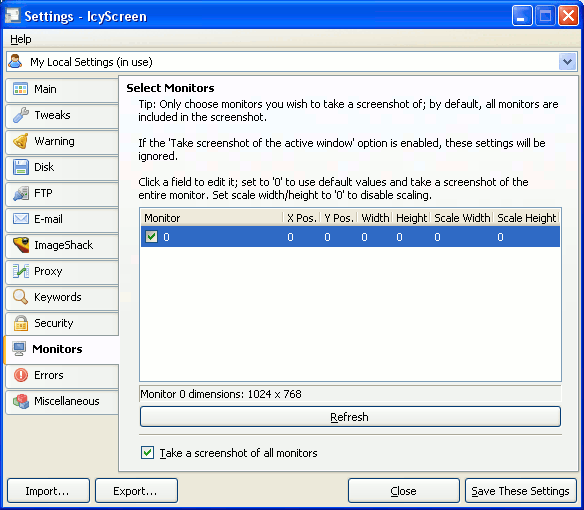 |
The monitor settings are extremely powerful. Many computers have multiple monitors connected to them. If your computer has multiple monitors, in this tab you can choose which ones to include in the screenshots captured by IcyScreen: each monitor that has a "check" mark next to it will be included.
Even if you only have one monitor connected to your computer, you'll still find the X/Y/width/height parameters useful -- you can use them to extract a certain section from each monitor.
There are several editable fields, all of which will be reset to their default if they are out of range:
X Pos.: X coordinate position (in pixels) of the monitor's screen to start taking a screenshot at. '0' is usually what you want.
Y Pos.: Y coordinate position (in pixels) of the monitor's screen to start taking a screenshot at. '0' is usually what you want.
Width: Number of pixels to grab from the screen, starting at the X position, going in a left-to-right direction. '0' is usually what you want; this will grab the entire width of the monitor's screen.
Height: Number of pixels to grab from the screen, starting at the Y position, going in a top-to-bottom direction. '0' is usually what you want; this will grab the entire height of the monitor's screen.
Scale Width: Width value (in pixels) to scale the screenshot for this monitor to. Set to '0' to not scale. Note: this will not scale the entire screenshot as a whole; only the screenshot taken from this monitor. This is useful if you would like to accentuate or attenuate a certain monitor from the entire screenshot.
Scale Height: Height value (in pixels) to scale the screenshot for this monitor to. Set to '0' to not scale. See the note above.
The following settings are global for all selected monitors:
Refresh: Click this button to refresh the list of currently available monitors.
Take a screenshot of all monitors: Selecting this will have IcyScreen take a screenshot of all of your monitors. This is a good idea to select if you may be adding monitors in the future; IcyScreen can automatically detect them and will automatically enable them for you so that they are included in the screenshots.
Go back to top |
Errors |
 |
Log errors to file: Log all errors to the file specified in the Save log to directory field.
Don't show pop-up on error: Don't show a pop-up dialog when an error occurs, as is the default functionality.
On error, try again in (seconds): If an error occurs, try again in this many seconds.
Maximum log file size (kB): The maximum size of the log file, in kilobytes. If the file reaches this size, the oldest log entry(s) in the file will be removed to make room for the new entry(s).
Save log to directory: Save the log file to this directory. If the directory does not exist, IcyScreen will attempt to create it automatically.
Format codes are supported in this entry.
File name: Save the log to the directory configured above, under this file name.
Format codes are supported in this entry.
Go back to top |
Miscellaneous |
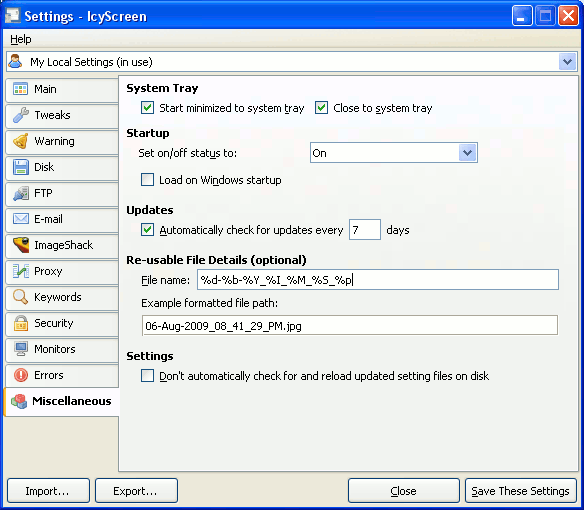 |
Start minimized to system tray: Check this to have IcyScreen start minimized to the system tray (the area on the bottom of your screen where the icons are; also known as the notification area) when it first loads.
Close to system tray: Check this to have IcyScreen hide itself and close to the system tray when the close ("X") button is clicked.
Set on/off status to: Choose IcyScreen's status when it first loads. There are three options:
- Last Used: Set the status to what it was when IcyScreen was last closed. That is, if IcyScreen was 'On' when IcyScreen was last closed, then the next time IcyScreen loads, it's status will be set to 'On'; likewise, if it was 'Off' when it was last closed, the next time IcyScreen loads, it's status will be set to 'Off'.
- On: Set IcyScreen's status to 'On' when it first loads.
- Off: Set IcyScreen's status to 'Off' when it first loads.
Load on Windows startup: Check this to have IcyScreen start itself with Windows. If the My Local Settings entry is selected in the username list, enabling this will make IcyScreen load on Windows startup for the current user (the one who is currently logged-in). If the Global Settings entry is selected in the username list, enabling this will make IcyScreen load on Windows startup for all users on the system. Otherwise, enabling this will make IcyScreen load for whichever user you currently have selected in the username list.
Automatically check for updates every X days: Select this to have IcyScreen check for program updates every X days. You'll only be notified -- via a message dialog -- if an update is available.
If an update is available, after the first time you are notified, you won't be notified again until another new version has been released.
Re-usable file details (optional): If you have "Use re-usable file details from the Miscellaneous tab" enabled in any screenshot saving/uploading method's tab, the details from the File name field below will be used instead of the details set in the respective setting's tab.
Don't automatically check for and reload updated setting files on disk: Every so often IcyScreen checks for an updated setting file on disk -- for the convenience of system administrators -- and will reload if it has been updated. If you'd rather this not happen, select this option. It's recommended you leave this option alone unless you know what you're doing, however.
Go back to top |
Users |
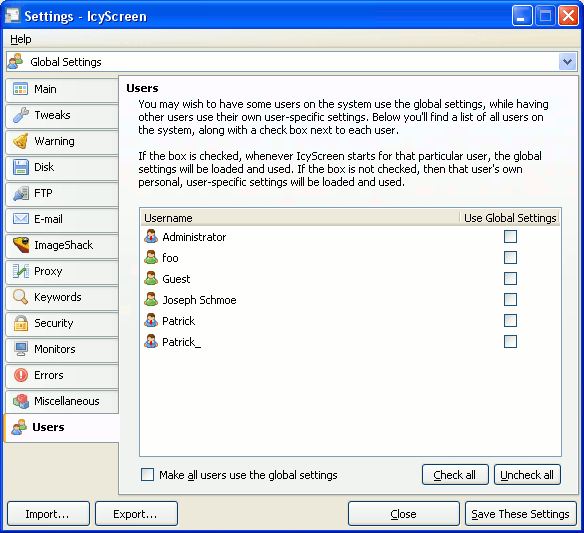 |
You may wish to have some users use the same set of settings, while having others use their own user-specific settings, tailored to their (or your) needs.
In this tab -- which is only visible when Global Settings is selected in the username list at the top of the setting window -- you'll find a box, filled with a list of the usernames that exist on the system. Each username has a check box next to it; the state of this check box (checked or unchecked) reflects whether or not this user should use the Global Settings.
If the box is checked, whenever IcyScreen loads for that particular user, or reloads the settings automatically, it will load and use the Global Settings. As stated at the top of this page, the Global Settings are accessible to all users on the system, though they can be write-protected to prevent limited users from modifying them (see the Security tab for more details).
If the box is not checked, then IcyScreen will load and use that particular user's own personal, user-specific settings -- set in USER's Settings if you are not configuring IcyScreen's settings while logged-in under that user's account, or in My Local Settings if you are configuring IcyScreen's settings while logged-in under that user's account.
As an example of how this tab can be extremely useful, say you have 100 users on the system, and you'd like 97 of them to use the same settings. The easiest thing to do, then, would be to set the settings you want those 97 users to use in the Global Settings, and then click Check all in the Users tab (which you're in right now).
Then, for the three users -- let's call them Bob, Bill, and Joe -- whom you'd like to use custom settings for, simply uncheck the check box next to their username in the username list in this Users tab, click Save These Settings, and then configure their personal settings by selecting their username in the username list at the top of the setting window.
After saving each user's individual settings, those three users -- Bob, Bill, and Joe -- will be using their own custom settings which you set for them, while the other 97 users will be using the same Global Settings.
If at any time you'd like Bob, Bill, and Joe to stop using their own user-specific settings, and start using the same Global Settings that all of the other users are using, simply check the box under the Use Global Settings column next to their username in the username list in this tab, and click Save These Settings.
You can also enable the Make all users use the global settings option, which will make all users on the system (even newly created ones, whom you haven't explicity configured in this tab) use the Global Settings.
Go back to top |
|
|